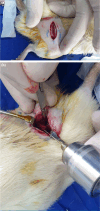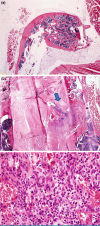The efficiency of ozone therapy in the prevention of heterotopic bone formation in an animal model
- PMID: 40783995
- PMCID: PMC12456343
- DOI: 10.52312/jdrs.2025.2174
The efficiency of ozone therapy in the prevention of heterotopic bone formation in an animal model
Abstract
Objectives: In our study, we aimed to evaluate the efficacy of prophylactic ozone therapy (OT) for heterotopic ossification (HO) development after hip surgery in a rat model.
Materials and methods: We randomly divided a total of 20 Wistar albino rats into two equal groups (n=10) as the control group (Group 1) receiving daily intraperitoneal injections of 1 mL of Ringer's lactate solution for a duration of two weeks after undergoing hip surgery and the group (Group 2) receiving OT daily at a dose of 1 mL of an ozone/oxygen combination via intraperitoneal route for a period of two weeks after hip surgery. Hip surgery was performed to mimic the formation of HO. After 12 weeks, the animals were evaluated functionally and sacrificed. Following sacrification, histopathological, and radiological assessments were performed.
Results: The modified Brooker staging method was used for radiological evaluation, and all animals in the control group showed at least Stage 1 HO formation. However, only three animals (30%) in the OT group showed HO formation (p=0.006). In histopathological evaluation, the median HO rates in the high power field were 42.5 (range, 30 to 55) in the control group and 0 (range, 0 to 25) in the OT group (p=0.003), and the median leukocyte count was 5.5 (range, 3 to 7) in the control group and 1 (range, 0 to 3) in the ozone group (p=0.006). Radiological HO, histopathological HO, and inflammation were significantly lower in the ozone group (p<0.05).
Conclusion: Our study results suggest that OT is effective in decreasing HO formation in rats following hip surgery.
Conflict of interest statement
Figures






References
MeSH terms
Substances
LinkOut - more resources
Full Text Sources
Medical

